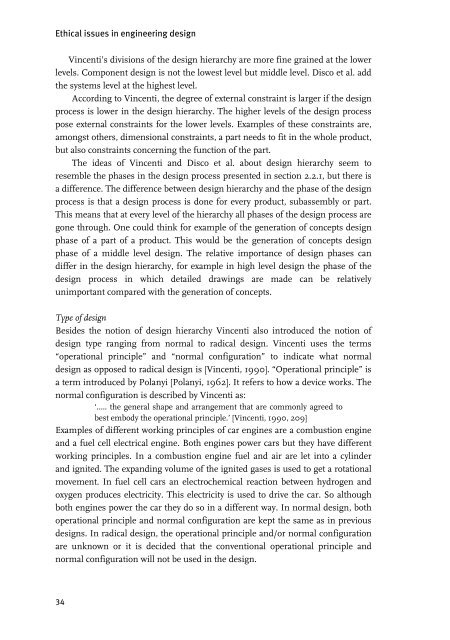Ethical issues in engineering design - 3TU.Centre for Ethics and ...
Ethical issues in engineering design - 3TU.Centre for Ethics and ...
Ethical issues in engineering design - 3TU.Centre for Ethics and ...
You also want an ePaper? Increase the reach of your titles
YUMPU automatically turns print PDFs into web optimized ePapers that Google loves.
<strong>Ethical</strong> <strong>issues</strong> <strong>in</strong> eng<strong>in</strong>eer<strong>in</strong>g <strong>design</strong><br />
V<strong>in</strong>centi’s divisions of the <strong>design</strong> hierarchy are more f<strong>in</strong>e gra<strong>in</strong>ed at the lower<br />
levels. Component <strong>design</strong> is not the lowest level but middle level. Disco et al. add<br />
the systems level at the highest level.<br />
Accord<strong>in</strong>g to V<strong>in</strong>centi, the degree of external constra<strong>in</strong>t is larger if the <strong>design</strong><br />
process is lower <strong>in</strong> the <strong>design</strong> hierarchy. The higher levels of the <strong>design</strong> process<br />
pose external constra<strong>in</strong>ts <strong>for</strong> the lower levels. Examples of these constra<strong>in</strong>ts are,<br />
amongst others, dimensional constra<strong>in</strong>ts, a part needs to fit <strong>in</strong> the whole product,<br />
but also constra<strong>in</strong>ts concern<strong>in</strong>g the function of the part.<br />
The ideas of V<strong>in</strong>centi <strong>and</strong> Disco et al. about <strong>design</strong> hierarchy seem to<br />
resemble the phases <strong>in</strong> the <strong>design</strong> process presented <strong>in</strong> section 2.2.1, but there is<br />
a difference. The difference between <strong>design</strong> hierarchy <strong>and</strong> the phase of the <strong>design</strong><br />
process is that a <strong>design</strong> process is done <strong>for</strong> every product, subassembly or part.<br />
This means that at every level of the hierarchy all phases of the <strong>design</strong> process are<br />
gone through. One could th<strong>in</strong>k <strong>for</strong> example of the generation of concepts <strong>design</strong><br />
phase of a part of a product. This would be the generation of concepts <strong>design</strong><br />
phase of a middle level <strong>design</strong>. The relative importance of <strong>design</strong> phases can<br />
differ <strong>in</strong> the <strong>design</strong> hierarchy, <strong>for</strong> example <strong>in</strong> high level <strong>design</strong> the phase of the<br />
<strong>design</strong> process <strong>in</strong> which detailed draw<strong>in</strong>gs are made can be relatively<br />
unimportant compared with the generation of concepts.<br />
Type of <strong>design</strong><br />
Besides the notion of <strong>design</strong> hierarchy V<strong>in</strong>centi also <strong>in</strong>troduced the notion of<br />
<strong>design</strong> type rang<strong>in</strong>g from normal to radical <strong>design</strong>. V<strong>in</strong>centi uses the terms<br />
“operational pr<strong>in</strong>ciple” <strong>and</strong> “normal configuration” to <strong>in</strong>dicate what normal<br />
<strong>design</strong> as opposed to radical <strong>design</strong> is [V<strong>in</strong>centi, 1990]. “Operational pr<strong>in</strong>ciple” is<br />
a term <strong>in</strong>troduced by Polanyi [Polanyi, 1962]. It refers to how a device works. The<br />
normal configuration is described by V<strong>in</strong>centi as:<br />
‘….. the general shape <strong>and</strong> arrangement that are commonly agreed to<br />
best embody the operational pr<strong>in</strong>ciple.’ [V<strong>in</strong>centi, 1990, 209]<br />
Examples of different work<strong>in</strong>g pr<strong>in</strong>ciples of car eng<strong>in</strong>es are a combustion eng<strong>in</strong>e<br />
<strong>and</strong> a fuel cell electrical eng<strong>in</strong>e. Both eng<strong>in</strong>es power cars but they have different<br />
work<strong>in</strong>g pr<strong>in</strong>ciples. In a combustion eng<strong>in</strong>e fuel <strong>and</strong> air are let <strong>in</strong>to a cyl<strong>in</strong>der<br />
<strong>and</strong> ignited. The exp<strong>and</strong><strong>in</strong>g volume of the ignited gases is used to get a rotational<br />
movement. In fuel cell cars an electrochemical reaction between hydrogen <strong>and</strong><br />
oxygen produces electricity. This electricity is used to drive the car. So although<br />
both eng<strong>in</strong>es power the car they do so <strong>in</strong> a different way. In normal <strong>design</strong>, both<br />
operational pr<strong>in</strong>ciple <strong>and</strong> normal configuration are kept the same as <strong>in</strong> previous<br />
<strong>design</strong>s. In radical <strong>design</strong>, the operational pr<strong>in</strong>ciple <strong>and</strong>/or normal configuration<br />
are unknown or it is decided that the conventional operational pr<strong>in</strong>ciple <strong>and</strong><br />
normal configuration will not be used <strong>in</strong> the <strong>design</strong>.<br />
34



